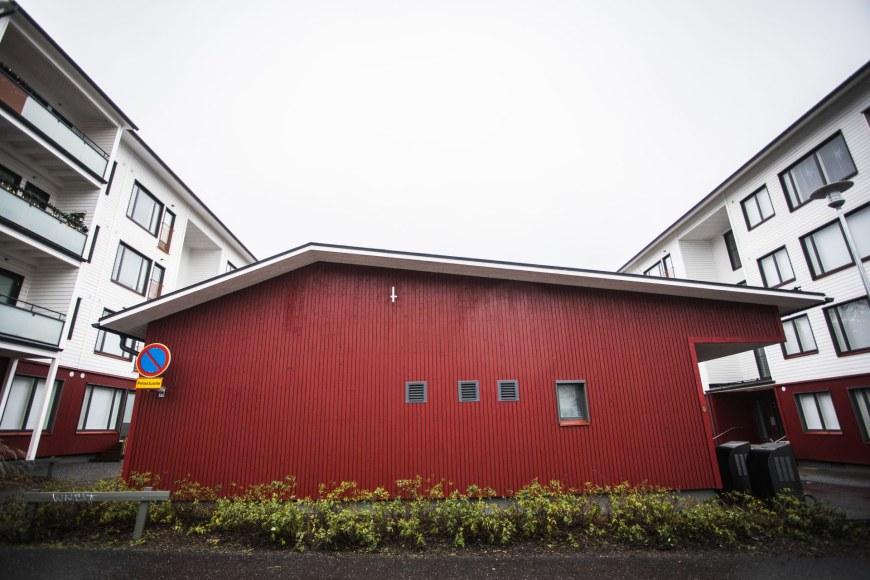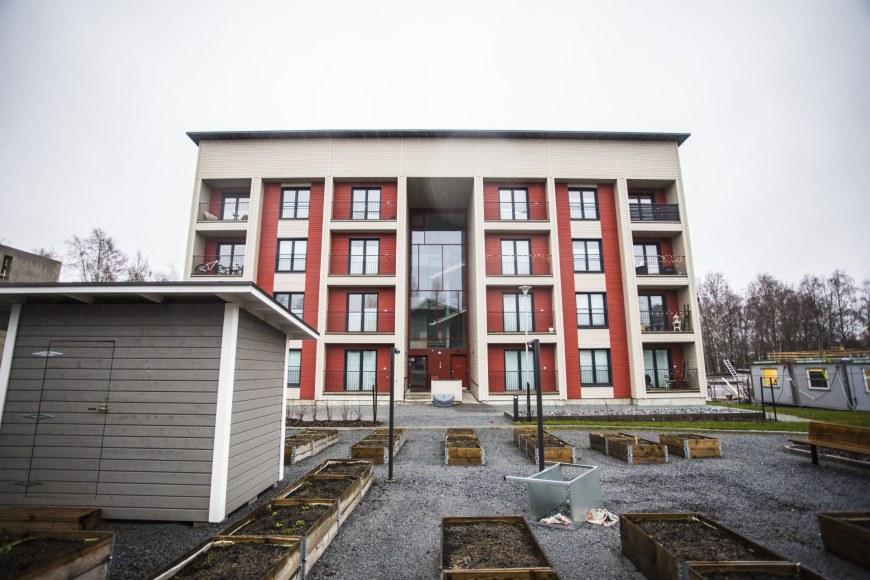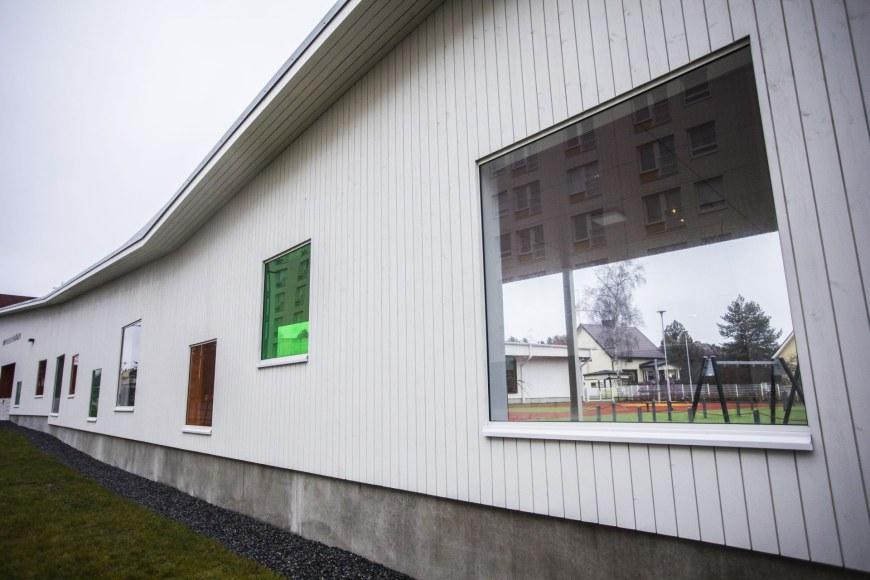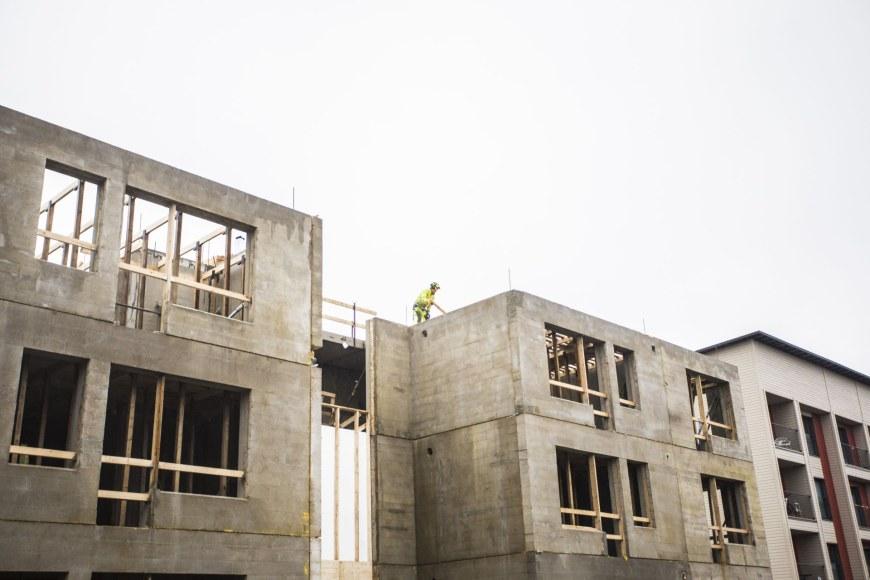Wood is a sustainable building material – but there is a money problem to solve

This article was originally published in Unit, the magazine of Tampere Universities.
In Finland, wood is the preferred material for building holiday homes. There are half a million summer cottages spread across the country, with 7,000 new ones sprouting up each year. As many as 99% of them are made of wood.
No surprises there – who would want a concrete eyesore in one’s holiday oasis?
However, the fact that Finland has the second highest rate of flat dwellers in Europe after Spain is sure to raise some eyebrows. In Finland, 46% of all properties are flats, and wood has never been the material of choice for blocks of flats. We choose wood for small-scale projects, but concrete for complex ones.
“Some 3,000 wooden flats have been added to Finland’s housing stock in the past 25 years, but as many as 30,000 concrete ones are added every year. There are currently only 103 wooden blocks of flats in Finland,” says Markku Karjalainen, professor of architectural construction at Tampere University.
With Finland being so richly endowed with forest resources, why is it that large-scale timber construction has not caught on?
One reason is the building code.
“The height restrictions on wooden blocks of flats were not loosened until relatively recently. For a long time, the use of wood was limited to low-rise buildings up to two storeys high for fire safety reasons,” Karjalainen explains.
Large-scale timber construction is stuck in a vicious cycle in Finland.
Another obstacle is price. Finland has world-class expertise in timber construction, but the industry faces a shortage of skilled engineers who are able to design demanding wooden structures. All this combined with the small number of large-scale timber construction projects adds up to a competitiveness problem.
“Developers with a positive attitude towards the use of wood are few and far between due to the general lack of experience, and also because professionals with the ability to manage timber construction processes are in short supply. This drives up construction costs, so timber is no longer seen as a viable option,” Karjalainen sums up.
Finland has a long way to go to catch up
Now let’s look to the rest of the world. The USA has a long tradition of building with wood, and even wooden blocks of flats have been built there for close to 150 years.
“Wood is a mainstream building material in the USA because both labour and timber are cheap. More than 80% of all new US homes are made of wood. Switzerland, Austria, Germany and Liechtenstein have a long history of timber construction in Europe, but even they lag behind the USA,” Karjalainen says.

In the Nordic countries, multi-storey wooden buildings did not begin to catch on until the mid-1990s. Since then, Sweden has pulled way ahead of Finland. The market share of wooden blocks of flats is 15–20% in Sweden, but only 2% in Finland. As a result, flats in a wooden block are typically 15–20% cheaper than similar units in a concrete block in Sweden, whereas the opposite holds true for Finland.
“Wooden blocks of flats should make up an estimated 15% of Finland’s housing stock for the market to be viable without government support. At least for now, the market depends heavily on government-run programmes and development projects. Neither the state nor cities can force private developers to use wood,” Karjalainen points out.
Large-scale timber construction is stuck in a vicious cycle in Finland: demand needs to pick up before we can drive down the costs of building larger and taller wood structures, refine building processes and close the skills gap. If the demand remains low due to the lack of skilled workers and process management expertise, the building costs will remain high.
In Finland, concrete has a 40-year head start on wood.
“To quote the CEO of a construction company, buildings are not made of wood, concrete or steel; they are made of money. We have to solve the money conundrum, no matter what tools or how many skilled workers there are,” says Henri Salonen, senior lecturer in structural engineering at Tampere University of Applied Sciences.
Wood is aesthetically appealing and moderates the indoor climate
Why, then, should we choose wood as a building material? One of the greatest attributes of wood is that it is a sustainable material. It is renewable and abundantly available in Finland. In addition, forests are one of our best defences against rising carbon dioxide levels. Growing trees absorb carbon, which is stored in the form of timber.
“One cubic metre of wood soaks up one tonne of carbon dioxide from the atmosphere and releases 750 kg of oxygen as a waste product of photosynthesis. A cubic metre of wood weighs 500 kg, and 50% of that weight is atmospheric carbon,” Karjalainen says.
Timber should be put into long-lived uses to extend the time the carbon is stored. When wood is used for cladding and framing buildings, the sequestered carbon remains locked up for the lifetime of the structure. If converted into pulp, paper or energy, the carbon is released back into the atmosphere in four years or less.
Living in a wooden home reduces blood pressure and stress levels like a walk in the woods.
Being a relatively lightweight building material, wood requires less preliminary site works and is cheaper to transport and easier to lift. A cubic metre of wood weighs 2,000 kg less than a cubic metre of concrete.
“Replacing concrete with timber is a sustainable choice, because concrete accounts for 7% of all global carbon emissions,” Karjalainen notes.

Wooden materials find favour among flat dwellers, too. Wood is a popular choice not only for interior design, such as floors and furniture, but also for façades and balconies.
“Based on resident feedback, the benefits of wood include not only sustainability but also aesthetic and architectural appeal, a pleasant environment and good indoor air quality. Wood absorbs humidity when the level of moisture in the air is high and releases it when the air is dry, thus balancing indoor humidity levels,” Karjalainen says.
The physiological benefits of wood on humans have been studied beyond indoor air quality. Preliminary findings indicate that living in a wooden home reduces blood pressure and stress levels like a walk in the woods.
Pros and cons
Although an excellent building material, wood is not perfect – it has special characteristics that must be considered during the building process.
A major drawback is that wood is combustible, so appropriate fire safety measures must be in place to ensure minimal risk. In Finland, all timber-frame and timber-clad buildings of more than two storeys must be equipped with an automatic sprinkler system.
“In terms of fire safety, they outperform concrete buildings of the same size that do not have sprinklers,” Karjalainen points out.
Another disadvantage is sensitivity to moisture. Wood that has a moisture content higher than 20% for a prolonged period will begin to rot. Birch plywood is particularly susceptible to moisture, and mould will quickly start to grow on the surface in damp conditions.
Keeping the structure dry is especially important when constructing a building that must meet demanding energy performance standards.
In the light of climate change, susceptibility to moisture sounds like bad news. Global warming will bring milder and rainier winters to Finland and increase the frequency of driving rain. Can wood withstand these conditions?
“If timber is protected from rain during the construction and installation stages, it will stay dry so long as the structure is constructed in accordance with the technical requirements. Naturally a wooden façade requires more maintenance than, for example, brick. Drainage systems and façade details must be carefully designed to ensure, among other things, that all joints are sealed against the weather,” Karjalainen says.
Keeping the structure dry is especially important when constructing a building that must meet demanding energy performance standards. It is possible that moisture that has penetrated the fabric of the building cannot escape if the exterior walls and roof are thickly insulated.
“Finland’s building regulations do not set out any specific requirements for the thickness of insulation, as the energy performance of a building is assessed as a whole. The risks associated with the evaporation of moisture can be reduced by installing a thinner layer of insulation and offsetting the heat losses with high-performance doors and windows and a geothermal heating system,” Salonen explains.
A further disadvantage is sound insulation. As wood is lightweight, impact sounds and other unwanted noise will easily travel through floors if they are not properly soundproofed. The trick is to use a larger mass – such as concrete – to join the floors together, but this technology requires special expertise.
A question of image
Large-scale timber construction has some way to go before it enters the mainstream in Finland.
“It seems that the requirements are becoming more stringent in step with the advances made in large-scale timber construction. This creates the impression that there is still a myriad of problems to be resolved, whereas in reality we have already taken significant steps forward,” Salonen says.

Finland’s fire safety requirements are no longer holding back the vertical ambitions of timber construction. Besides tall residential buildings, wood can already be used to build multi-storey office buildings, nursing homes and residential care homes for the elderly as well as hotels and motels. The height threshold for wooden schools, conference and sports centres and commercial buildings has likewise been raised from two to four.
Since 1996, all Finnish government programmes have included a pledge to support timber construction. Cities and municipalities are leading the way in the rise of large-scale timber construction: they are actively zoning areas for wooden buildings, and wood has become an especially popular material for building schools and kindergartens.
To bridge the skills gap, a new doctoral school in industrial timber construction will be launched in Tampere in 2021. The doctoral school will address the challenges of timber construction and produce new professionals.
The appeal of timber construction as an investment proposition is growing. Property developers and major customers are increasingly opting for wood. Besides money, brand image plays an important role in the decision-making process.
“Wood is intricately tied to brand identity and image. A forest industry company will obviously choose wood over concrete when building a new headquarters, but there are also many others who realise that the use of wood as a building material can help create a positive brand image,“ Salonen notes.
More bulk and closer collaboration
Now to the key question: how much timber must a building contain to be called wooden?
“According to Finland's building code and statistics, the load-bearing frame determines whether a building is classified as wooden or concrete. When talking about timber construction, we mean timber-frame buildings,” Karjalainen explains.
Karjalainen does not take such a purist view and prefers to talk about the use of wood in architecture and construction.
“Talking about timber construction easily conjures up an image of one advocating the use of wood for all purposes, however unsuitable it might be. Wood can also be alongside other materials in the building frame or the interior or exterior cladding. Not everything has to be made of wood,” Karjalainen notes.
We often jump in at the deep.
Wood is an extremely versatile material. It can be machined into a variety of shapes – such as sheets, panels, shingles, slats and planks – and its appearance altered with different finishes. In fact, Karjalainen is calling for the more creative use of wood in architecture.
“The wooden blocks of flats built in Finland tend to be white, black or grey boxes without eaves. I am not saying they should be painstakingly ornate, but they could do with a pinch of imagination,” Karjalainen says.

Still, prefabricated modules that are assembled on site in Lego-like fashion can dramatically increase construction productivity.
“Modular construction does limit architectural design options but speeds up delivery and cuts costs,” Salonen says.
Concrete architecture dominated Finland’s post-war landscape, but Salonen believes now is the time for the country to experience a similar building boom in timber.
“We should first focus on simple and efficient large-scale timber construction projects before moving on to more complex ones. Now we often jump in at the deep end and set our sights on building overly complicated structures and always going taller,” he adds.
Stakeholders in the wood industry need to engage in closer collaboration to champion wood as a building material for large-scale structures, according to Salonen.
“The key is that all the players move forward as a united front, with no one making any sudden lunges for the finish line.”
Author: Sari Laapotti







